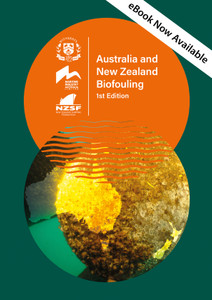
This fully illustrated publication describes in detail the problems that biofouling can cause to ship operations and the marine environment. It examines the use of anti-fouling systems to prevent the build-up of biofouling as well as the options available for ship cleaning, in particular the importance of in-water cleaning. It also sets out the revised 2023 IMO Biofouling Guidelines, specific regional mandatory biofouling requirements and the mandatory IMO AFS Convention. This edition includes data sheets for a number of in-water hull cleaning companies worldwide.
The build-up of biofouling can have a significant impact on ship hydrodynamics and energy efficiency as well as interfere with efficient operation of internal seawater systems. It can also threaten the marine environment through the transfer of non-native invasive species, or through the use of anti-fouling systems containing certain toxic substances.
This publication identifies ship structures that are vulnerable to biofouling, factors affecting the rate of build-up and the effect of biofouling on performance and operating costs.
It looks in detail at biofouling management, including the use of biocidal and non-biocidal paints and coatings, corrosion, marine growth prevention systems, in-water cleaning and treatment in dry dock. It briefly discusses several examples of environmental research initiatives into the effects of biofouling.
The publication sets out current biofouling legislative requirements, including IMO's recently revised 2023 Biofouling Guidelines, updates to the International Convention on the Control of Harmful Anti-fouling Systems on Ships (AFS Convention), and individual national and regional biofouling legislation. It provides templates for the Biofouling Management Plan and the Biofouling Record Book from the updated 2023 Biofouling Guidelines.
Finally, it provides a selection of data sheets summarising the services offered and area of operation of hull cleaning and inspection companies worldwide. This section includes world maps to enable readers to quickly identify companies operating in particular geographic locations.
Acknowledgements
Part 1 Background
Chapter 1 Background
1.1 What is Biofouling?
1.2 The Establishment of Biofouling
1.3 Corrosion
1.3.1 Microbiologically Influenced Corrosion
1.3.2 Cathodic Protection
1.4 Invasive Species
Part 2 Biofouling and the Ship
Chapter 2 Ship as a Carrier
2.1 Biofouling Assessment
2.2 Areas of Attachment on a Ship
2.3 Newbuild Design to Minimise Biofouling
2.4 Operational Profile and Maintenance of the Ship/Marine Structure
2.4.1 Type of Ship and its Charter Profile
2.4.2 Operating in Different Environments
2.5 Marine Structures/Devices
Chapter 3 Biofouling and Ship Performance
3.1 Effect of Biofouling on Ship Hydrodynamics and Energy Efficiency
3.1.1 IMO Measures and Guidance for Energy Efficiency
3.1.2 ISO Standards
3.2 Biofouling Cost Effects
Chapter 4 Biofouling, Biosecurity and Research
4.1 The Effects of Biofouling on the Marine Environment
4.1.1 The Effects of Biofouling Control and Removal
4.2 Environmental Research Initiatives
4.2.1 The GloFouling Partnership Project
4.2.2 The TEST Biofouling Project
4.2.3 The COMPLETE Project
4.2.4 The BioFREE Project
4.2.5 The OCEANIC Project
4.2.6 The Wave and Energy Project (WEP+)
4.2.7 The Flinders Biofilm Research and Innovation Consortium (BRIC) Project
4.2.8 The MultiFlex Project
4.2.9 HCR Project (a CORDIS Project)
4.2.10 Autonomous Biofouling Inspection Robots Research
Part 3 Biofouling Management
Chapter 5 Anti-fouling Systems (AFS)
5.1 Biocidal Paints and Coatings
5.1.1 Ablative or Soluble Matrix Coatings
5.1.2 Contact Leaching
5.1.3 Self-polishing Copolymer (SPC)
5.2 Non-Biocidal and Hybrid AFS
5.2.1 Foul Release Coatings (FRC)
5.2.2 Hard Inert Coatings
5.3 Marine Growth Prevention Systems (MGPS)
5.3.1 Anodic Copper Systems
5.3.2 Electrochlorination
5.3.3 Direct Chemical Dosing
5.3.4 Ultrasound
5.4 Selecting an AFS/AFC
5.5 Application of AFS/AFC
5.5.1 Applying AFS/AFC to Specific Niche Areas
5.5.2 Proper Application of AFC
Chapter 6 Ship Cleaning
6.1 In-water Cleaning
6.1.1 Brush Systems
6.1.2 Soft Tools
6.1.3 Water Jet and Air Jet (Blast) Systems
6.1.4 AFS Resistance to Cleaning
6.1.5 Propeller Cleaning
6.1.6 Proactive In-water Cleaning
6.1.7 The Future of In-water Hull Cleaning (IWHC)
6.2 Cleaning/Maintenance in Dry Dock
6.2.1 Dry-docking Planning Considerations
6.2.2 Hydroblasting
6.2.3 Abrasive Blasting
6.3 Hull Cleaning and Ship Operations
Part 4 Legislation and Guidelines
Chapter 7 The 2023 Biofouling Guidelines
7.1 The 2023 'Guidelines for the Control and Management of Ships' Biofouling to Minimize the Transfer of Invasive Aquatic Species? (2023 Biofouling Guidelines)
7.2 Design and Construction
7.3 Anti-fouling Systems (AFS)
7.4 Niche Areas
7.5 In-water Operations: Inspection, Cleaning and Maintenance
7.5.1 In-water Inspection
7.5.2 In-water Cleaning and Maintenance
7.6 The Biofouling Management Plan and Record Book
7.6.1 The Biofouling Management Plan (BFMP)
7.6.2 The Biofouling Record Book (BFRB)
7.6.3 Training and Education
Chapter 8 Regulations for the Control of Anti-Fouling Systems (AFS)
8.1 The International Convention on the Control of Harmful Anti-fouling Systems on Ships (AFS Convention)
Chapter 9 National and Regional Biofouling Legislation
9.1 Australia
9.2 New Zealand
9.2.1 Acceptable Measures
9.2.2 Documentation
9.2.3 Non-compliance
9.3 United States of America
9.3.1 Federal Law
9.4 Individual US State Biofouling Requirements
9.4.1 California
9.4.2 Hawaii
9.4.3 Maine
9.4.4 Washington
9.5 Polar Waters
9.6 Belgium
9.7 United Kingdom
9.8 Further National and Regional Fouling Management Requirements
9.9 Ships Affected by National Regulations
Appendices
Appendix 1 Example Form of Biofouling Management Plan (from Appendix 3 in the 2023 Biofouling Guidelines)
Appendix 2 Example Form of Biofouling Record Book (from Appendix 4 in the 2023 Biofouling Guidelines)
Appendix 3 Data Sheets for Hull Cleaning Companies
Appendix 4 Ship Wetted Surface Area (WSA) Information
References
Witherbys
Witherbys titles are developed using scripts developed by technical experts that are peer reviewed within work groups. Typically, they seek to improve understanding of the regulations, recommendations and guidelines issued by Industry.
Witherbys staff have significant expertise in the fields of navigation and hazardous cargoes as well as in the presentation of complex subjects in a graphic and easy to understand manner.
BIMCO
BIMCO is the world?s largest direct-membership organisation for shipowners, charterers, shipbrokers and agents. In total, around 60% of the world?s merchant fleet is a BIMCO member, measured by tonnage (weight of the unloaded ships).
The organisation has NGO status and is based in Copenhagen, Denmark, with offices in Athens, Singapore and Shanghai.
With around 1900 member companies across 120 countries, from the largest shipowners in the world to small local port agents and law firms, BIMCO represents a wide range of maritime companies and organisations.
BIMCO?s goal is to secure a level playing field for the global shipping industry. BIMCO therefore works to promote and secure global standards and regulations for the maritime sector. The organisation?s century long effort into creating standard contracts and clauses is an expression of that aim.
The International Chamber of Shipping (ICS)
ICS is the principal international trade association for the shipping industry, representing shipowners and operators in all sectors and trades. ICS membership comprises national shipowners' associations in Asia, Europe and the Americas whose member shipping companies operate over 80% of the world's merchant tonnage.
Established in 1921, ICS is concerned with all technical, legal, employment affairs and policy issues that may affect international shipping.
ICS represents shipowners with the various intergovernmental regulatory bodies that impact on shipping, including the International Maritime Organization.
ICS also develops best practices and guidance, including a wide range of publications and free resources that are used by ship operators globally.
https://www.ics-shipping.org/about-ics/
- Number of Pages:
- 204
- Published Date:
- October 2024
- Book Height:
- 305 mm
- Book Width:
- 220 mm
- Publication Date:
- October 2024
- Author:
Witherbys, BIMCO and International Chamber of Shipping
- Weight:
- 1.4 kg
- ISBN:
- 9781917308069
- Preview:
- Yes






